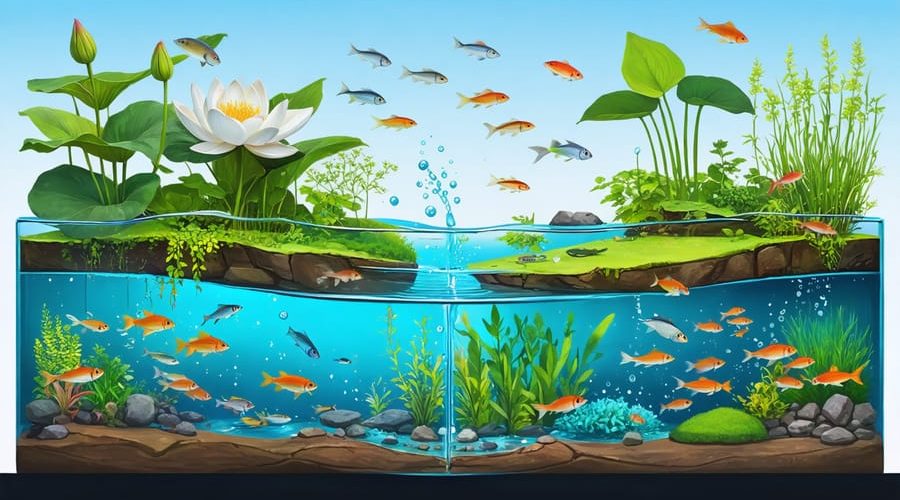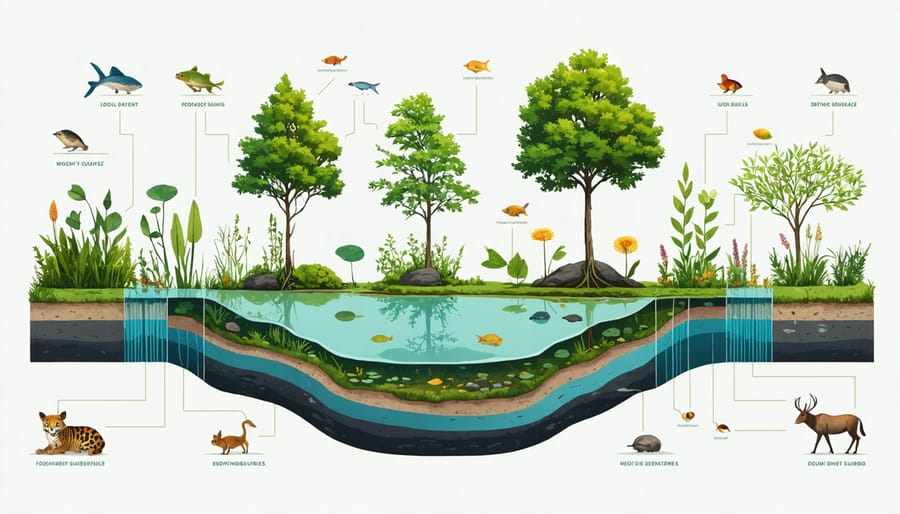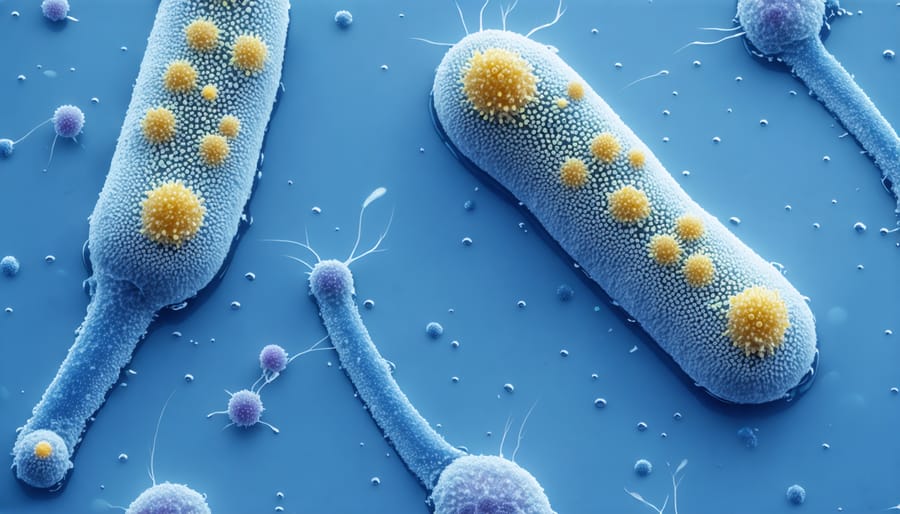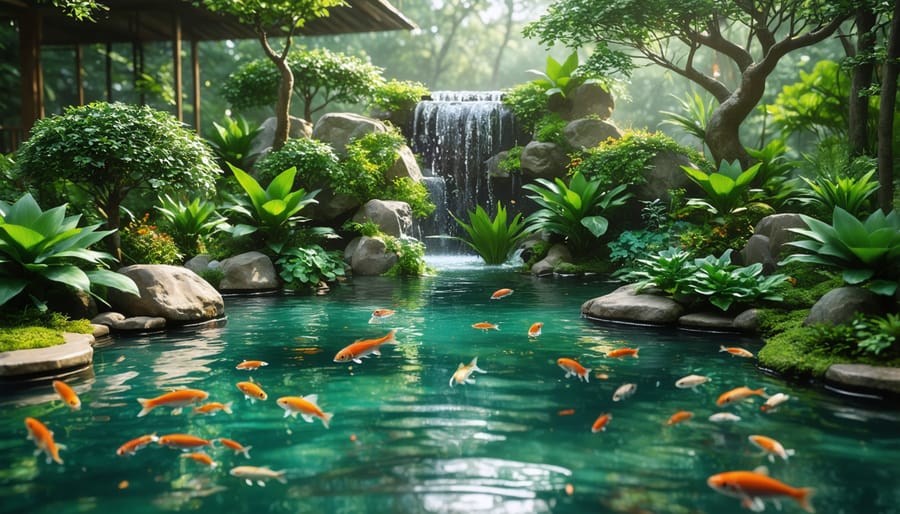
Transform Your Water Garden: Amazing Secrets of Aquatic Ecosystems
Dive into the fascinating world of aquatic ecosystems, where every ripple tells a story of intricate relationships between water, plants, and wildlife. These underwater worlds, from backyard ponds to vast oceans, function as living laboratories that demonstrate nature’s perfect balance. Whether you’re creating your first water garden or deepening your understanding of natural pond dynamics, embarking on an aquatic ecosystem journey reveals how oxygen, nutrients, and biological processes work together to sustain life. Understanding these fundamental relationships helps pond owners create healthier, more sustainable water features that practically maintain themselves. From the smallest microorganisms to larger aquatic plants and fish, each element plays a crucial role in maintaining water quality and ecological balance. This knowledge transforms simple water gardens into thriving, self-sustaining ecosystems that provide years of enjoyment with minimal intervention.
The Living Web in Your Pond
The Three Zones of Life
Just like a layer cake, pond ecosystems are divided into three distinct zones, each playing a vital role in the overall health of your water garden. The surface zone, also known as the littoral zone, is where sunlight penetrates most strongly. This is where you’ll find your floating plants like water lilies and where most photosynthesis occurs. It’s also where fish come up to feed and where you’ll spot most wildlife activity.
The middle zone, or limnetic zone, is the open-water area where many fish spend their time. This area acts as a transition space and helps maintain water circulation throughout your pond. You’ll often see fish darting through this zone during the day, especially during feeding times.
The bottom zone, called the benthic zone, is where organic matter settles and decomposition occurs. This area is home to beneficial bacteria and small organisms that break down debris. While it might seem less exciting, this zone is crucial for nutrient cycling and keeping your pond healthy. Good pond design considers all three zones to create a balanced ecosystem.

Nature’s Perfect Balance
In a healthy aquatic ecosystem, every organism plays a vital role in creating a perfect balance. Plants serve as natural filters, absorbing excess nutrients and providing oxygen through photosynthesis. Meanwhile, fish contribute by producing waste that becomes fertilizer for the plants, creating a beautiful cycle of give and take. The real magic happens at the microscopic level, where beneficial bacteria break down organic matter and convert harmful compounds into nutrients that help maintain thriving pond life.
Think of your pond as a tiny underwater city where everyone has a job. Floating plants provide shade and shelter, while submerged plants oxygenate the water. Fish keep insect populations in check and add movement and life to your water garden. Snails and other small creatures work as nature’s cleanup crew, managing algae and debris. Even the smallest microorganisms contribute by processing waste and keeping the water clear.
This delicate balance creates a self-sustaining environment that, when properly established, requires minimal intervention from you. It’s nature’s way of showing us that the best solutions are often the simplest ones!
Your Pond’s Hidden Heroes
Beneficial Bacteria
Just like a city needs its sanitation workers, aquatic ecosystems rely on beneficial bacteria to keep things clean and healthy. These microscopic helpers break down waste, fallen leaves, and other organic matter that would otherwise pollute your pond water. Think of them as nature’s cleaning crew!
The most important bacteria in your pond are two types: the ones that convert harmful ammonia into nitrites, and others that transform those nitrites into safer nitrates. This process, known as the nitrogen cycle, is essential for maintaining crystal-clear water and healthy fish.
These helpful bacteria naturally colonize your pond’s surfaces – rocks, gravel, filter media, and even plant roots. During warmer months, they work overtime processing waste, while in winter, they slow down but never completely stop. To keep your beneficial bacteria thriving, avoid using harsh chemicals that might harm them, and consider adding bacterial supplements during spring startup or after major cleanings.
Remember, a healthy bacterial colony means less maintenance work for you and a more balanced ecosystem for your aquatic plants and fish.

Tiny Cleaners
In the bustling underwater world of your pond, there’s a fascinating cleanup crew working around the clock – microscopic organisms that feast on algae. These tiny cleaners, including rotifers, water fleas, and various protozoans, play a crucial role in maintaining crystal-clear water. Like nature’s own maintenance team, they nibble away at excess algae, helping to prevent those unwanted green blooms that can cloud your pond.
What’s particularly amazing about these microorganisms is their efficiency. A healthy population can filter several gallons of water per day, breaking down not just algae but also other organic matter. They form the base of your pond’s food chain, supporting larger creatures like fish and amphibians.
The best part? These helpful cleaners establish themselves naturally in well-balanced ponds. You can encourage their presence by maintaining proper water quality and avoiding harsh chemicals that might harm these beneficial organisms. Think of them as your pond’s microscopic gardeners, tirelessly working to keep your aquatic paradise clean and healthy.
Creating Your Perfect Ecosystem

Plant Selection Secrets
Selecting the right mix of aquatic plants is crucial for creating a balanced ecosystem in your water garden. Start with a combination of submerged, floating, and marginal plants to create different layers in your pond. Underwater plants like hornwort and anacharis are excellent oxygenators, helping maintain water quality while providing shelter for pond life.
For the surface layer, consider adding water lilies or lotus flowers. These not only create stunning visual displays but also provide essential shade that helps control algae growth and keeps the water temperature stable. Aim to cover about 60% of your pond’s surface with floating plants.
Along the edges, marginal plants like iris, rush, and cattails create a natural transition between water and land. These plants help filter excess nutrients and provide vital spawning areas for wildlife. When choosing marginals, remember to plant them at the correct depth – usually indicated on their tags.
For best results, include a mix of native species that are well-adapted to your local climate. Native plants typically require less maintenance and naturally attract local wildlife. Start with a few varieties and gradually expand your collection as you become more comfortable with pond gardening. Remember that some plants can be aggressive growers, so research their growth habits before adding them to your ecosystem.
Fish Community Planning
Creating a balanced fish community is like planning a neighborhood where everyone gets along. Start by choosing fish that naturally coexist in similar environments. For example, koi and goldfish make excellent companions, as they share similar temperature and water quality needs. However, avoid mixing aggressive species like cichlids with more peaceful fish like guppies.
Consider the size of your pond when selecting fish. A good rule of thumb is one inch of fish per ten gallons of water. Remember that fish will grow, so plan for their adult size. Some species, like koi, can reach lengths of up to 36 inches!
Layer your fish community by including different swimming levels. Surface feeders like mollies help control mosquito larvae, mid-water swimmers like tetras add movement throughout the pond, and bottom dwellers like plecos help keep the substrate clean.
Temperature compatibility is crucial. Tropical fish need warmer waters, while cold-water species like golden orfe thrive in cooler conditions. Group fish with similar temperature requirements to ensure everyone stays comfortable year-round.
Don’t forget about feeding habits. Some fish are herbivores, others carnivores, and many are omnivores. A mix of feeding preferences helps maintain natural balance and prevents competition for food. Start with hardy species and gradually introduce more delicate fish once your ecosystem stabilizes.
Simple Monitoring Tips
Monitoring your aquatic ecosystem doesn’t require expensive equipment or a science degree. Here are some simple ways to check your water garden’s health that anyone can do at home.
First, make a habit of observing your water’s clarity. Clear water usually indicates good health, while consistently murky water might signal an imbalance. Try the “elbow test” – if you can see your submerged elbow when reaching into the water, that’s a good sign!
Watch your fish’s behavior. Happy, healthy fish are active and eat well. If they’re gasping at the surface or seeming lethargic, your oxygen levels might be low. Count the number of fish visible during feeding time – sudden changes could indicate health issues.
Pay attention to your plants. Healthy aquatic plants should have vibrant colors and steady growth. Yellow or browning leaves might suggest nutrient deficiencies or poor water quality. Keep an eye on algae growth too – while some is natural, excessive growth indicates nutrient imbalance.
Simple pH test strips from any garden store can give you valuable information about your water chemistry. Test weekly and keep a small notebook to track changes. Look for readings between 6.5 and 8.5 for most pond life.
Listen to your pond! A healthy ecosystem has a subtle symphony of sounds – water movement, occasional splashing, and active wildlife. If things seem unusually quiet, it’s worth investigating further.
Smell matters too. A healthy pond has little to no odor. If you notice strong, unpleasant smells, something might be off with your water quality or filtration system.
Remember, prevention is better than cure. Regular monitoring helps you spot potential problems before they become serious issues.
As we’ve explored, aquatic ecosystems are fascinating miniature worlds that bring life and beauty to our outdoor spaces. From the delicate balance of beneficial bacteria to the crucial role of aquatic plants, every element works together to create a thriving environment. Whether you’re starting with a small container pond or planning a larger water feature, remember that patience and observation are your best tools. The rewards of maintaining a healthy aquatic ecosystem are endless – from the soothing sound of flowing water to the joy of watching fish and wildlife make your pond their home. Take the first step today by applying these principles, and you’ll soon discover the wonderful world of water gardening. Your own backyard oasis awaits!
